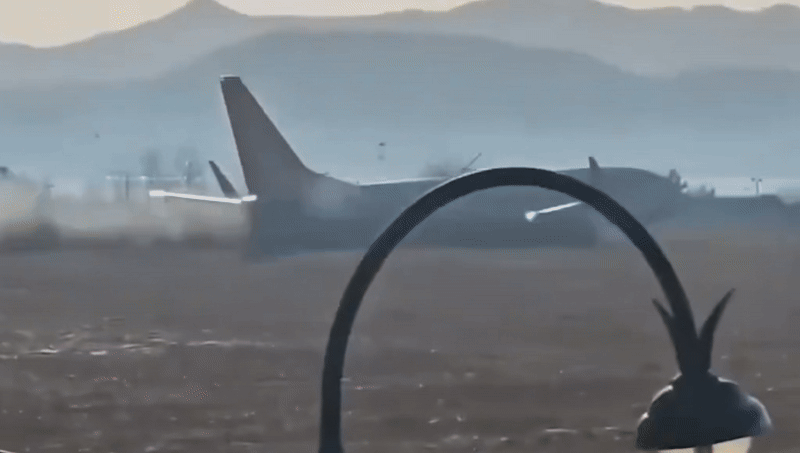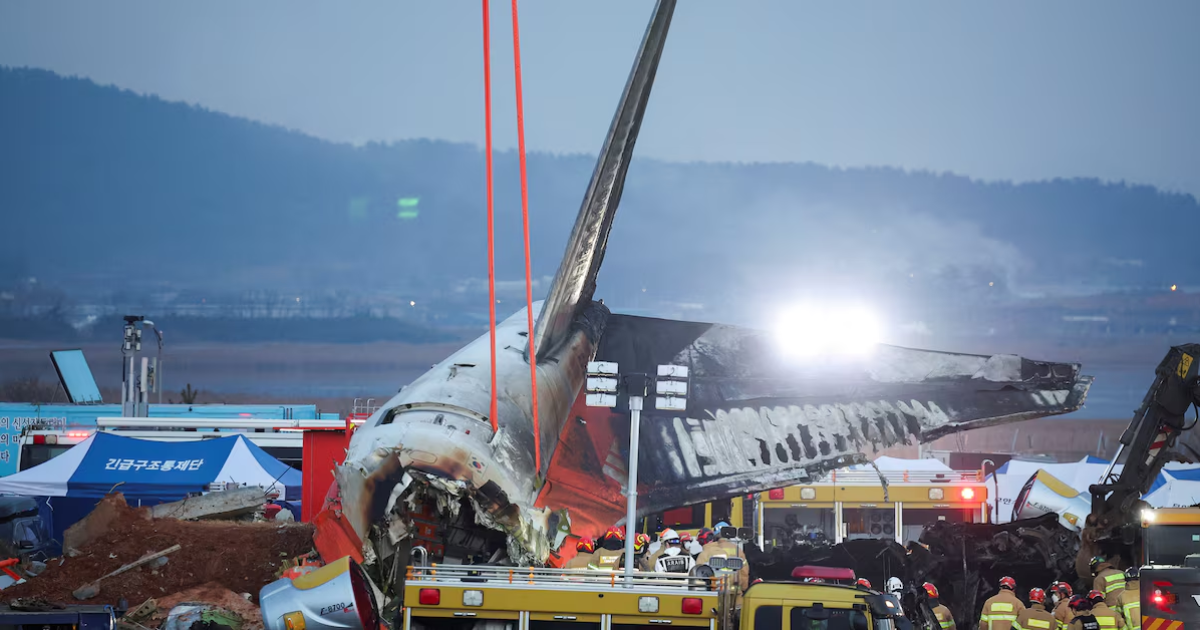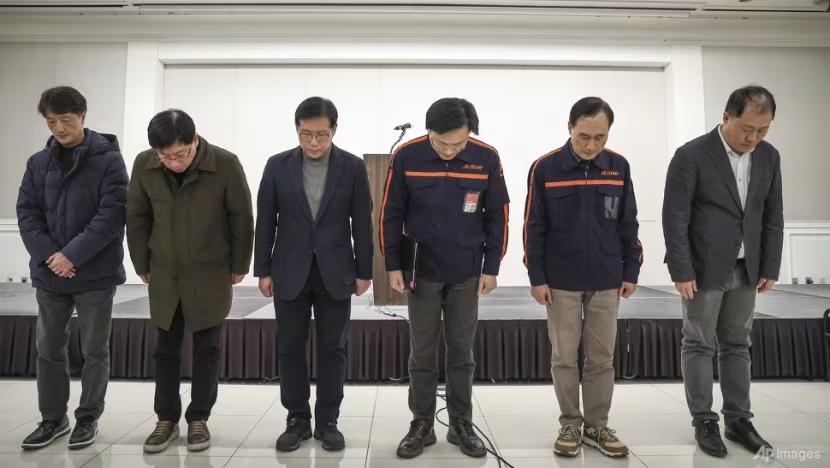A Jeju Air flight crashed when it was arriving at South Korea’s Muan International Airport.
Yes, you read that right. Last week, there was the Azerbaijan Air plane crash. Now, there’s the Jeju Air plane crash.
If you’ve yet to hear about the plane crash, fret not. Here are 10 facts about the Jeju Air plane crash that are known so far.
What Happened in the Jeju Air Plane Crash
On Sunday (29 December), many were shocked by the news of what happened to Jeju Air flight 7C2216. The flight had departed from the Thai capital of Bangkok and was headed for South Korea’s Muan International Airport.
However, when the flight attempted to land at the Muan International Airport, its landing gear did not deploy. Instead, the plane skidded down the runway and exploded into flames as it slammed into a wall at the end of the runway.

The crash also left most of the plane unrecognisable, with only the tail section of the plane retaining a semblance of its original shape.

Following the crash, all domestic and international flights at the Muan International Airport were cancelled.
179 People Killed; 2 Survived
The flight carried a total of 181 people. Unfortunately, except for two crew members who were rescued from the tail section of the plane, all others on board were killed in the crash.

If you do the math, that means 179 people were killed in the crash.
According to the South Korean transport ministry, aside from two Thai nationals, all passengers on board were believed to be South Koreans. Many appeared to be residents staying in areas near the airport, and were just returning from vacation.
The deceased passengers included passengers as young as three years old, and passengers as old as 78 years old.
Mortuary vehicles waited outside to transport the bodies of the deceased away. A temporary morgue has also been established to hold these bodies.
As for the two surviving crew members, a 25-year-old and a 33-year-old, they suffered medium to severe injuries.
South Korea Leading Civil Investigation into the Crash
Investigations into the plane crash have since begun. South Korea will lead a civil investigation into the crash, and under global aviation rules, the National Transportation Safety Board (NTSB) from the US, where the aircraft was designed and built, will be involved as well.
On the NTSB’s end, it shared that a team of US investigators was assisting South Korea’s aviation authority with the investigation.
Boeing, which manufactured the aircraft, as well as the US’s Federal Aviation Administration, are also involved in the investigations.
The Cause of the Jeju Air Plane Crash
So, what exactly caused the deadly crash? Well, we don’t know as of yet either. What we do know so far are the conditions surrounding the crash — here’s what they are.
According to the South Korean transport ministry, the control tower had issued a warning about bird strikes. A few minutes after the warning was issued, the flight’s pilots declared “mayday”.
But here’s the thing — although the pilots declared “mayday”, they did not specify whether the flight struck any birds.
However, a text exchange between a passenger on the flight and their family member seems to point to a bird strike as the cause of the crash.
In the text exchange, the passenger stated that the plane could not land as a bird was stuck in the plane’s wing. The passenger’s final text to their family member read: “Should I say my last words?”
Here’s the full text exchange, if you’re one of those people who can read Korean because of all the K-dramas you’ve watched:

But were the bird strikes solely responsible for the plane crash? Well, it seems to be the case, as the aircraft itself seemed to be fine before the bird strike warning was issued. According to Jeju Air CEO Kim E-bae, the aircraft involved in the crash did not show any early signs of malfunction.
Further, according to the President of the Airports of Thailand, Kerati Kijmanawat, no abnormal conditions were reported when the aircraft took off from Bangkok.
As such, the officials investigating the crash seem to be mainly looking into a bird strike and poor weather as the main causes of the plane crash.
Aircraft Involved in Crash is One of the World’s Most Flown Airliners
Earlier, we found out that Boeing was also involved in the investigations into the plane crash. This is because the aircraft involved in the crash was a Boeing 737-800 jet.
But before you start spreading the news to your family members to avoid Boeing flights again, here’s something you should know. The Boeing 737-800 model is actually one of the world’s most-flown airliners.
Further, this particular Boeing model has a generally strong safety record. It was developed before Boeing’s MAX variants — the airliners involved in Boeing’s recent safety crisis.
Yes, the safety crisis involving the Ethiopian Airlines flight and the Lion Air flight.
Whether or not the current Jeju Air plane crash signals another safety crisis for Boeing, we can’t say for sure. But what we can say is that defects with the aircraft itself don’t appear to be a main cause for the Jeju Air plane crash — instead, as we mentioned earlier, the plane crash seems to be caused by bird strikes or poor weather.
So, don’t start boycotting Boeing again as of yet lah, hor?
Acting South Korean President Declared National Mourning Period
Following the crash, South Korean acting president Choi Sang-mok has declared a national mourning period for the plane crash until 4 January.
Huh? Wait… Who is Choi Sang-mok? Wasn’t the acting president some guy called Han Duck-soo?
Well, about that — he was impeached as well. Choi Sang-mok has now been named the interim leader of South Korea instead. You can read more about Han Duck-soo’s impeachment here.
Changing president like changing clothes like that.
Jeju Air CEO Kim E-Bae Apologised for Plane Crash
Following the crash, Jeju Air CEO Kim E-bae has also stepped up to apologise for the tragic accident.
Kim and five other executive members were seen bowing in apology before a short media briefing about the accident.

During the media briefing, Kim shared that Jeju Air would cooperate with the investigations and would make supporting the bereaved its top priority.
Jeju Air Shares Hit Their Lowest on Record
Following the crash, Jeju Air’s shares have also been hit hard. On Monday (30 December), the budget carrier’s shares hit their lowest on record.
We won’t bore you with all the numbers and financial terms, but all you have to know is that Jeju Air’s shares fell to the lowest it has been since it was listed in 2015.
Even the shares of Jeju Air’s holding company were affected. The shares of AK Holdings fell by as much as 12% and hit its lowest in 16 years as well.
Not very heng, ong, huat.
Jeju Air’s First Fatal Flight
Here’s something else you should know — the current plane crash is Jeju’s Air first fatal flight.
Earlier in 2007, a flight operated by Jeju Air did result in injuries, but no deaths were reported. The flight, a Bombardier Q400, was carrying 74 passengers. It veered off the runway at the Busan-Gimhae airport and caused a dozen injuries.
But now, the airline will have a fatal flight inked permanently in its history lah.
Deadliest Plane Crash for South Korean Airlines in Nearly Three Decades
Not only is this plane crash Jeju Air’s first fatal flight, but it’s also the deadliest that South Korea has seen in nearly three decades.
Before the Jeju Air plane crash, the deadliest plane crash for any South Korean airline happened back in 1997 — a whopping 27 years ago.
In 1997, Korean Airlines Flight 801 crashed at Guam International Airport, otherwise known as the Antonio B. Won Pat International Airport. The crash killed 228 of the 254 people on board, with 23 passengers and 3 crew members surviving with serious injuries.




